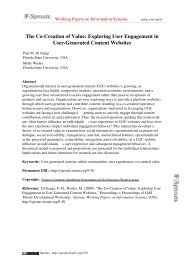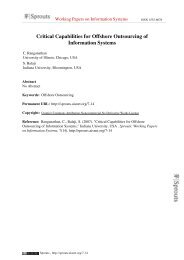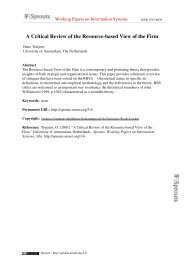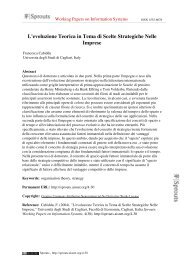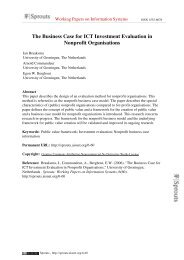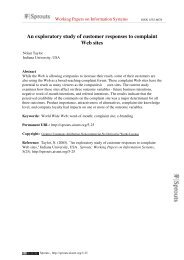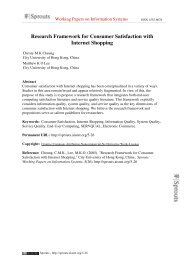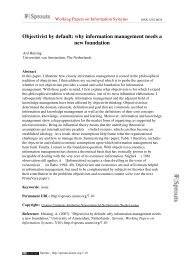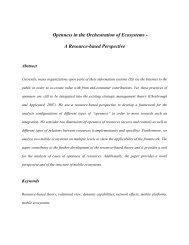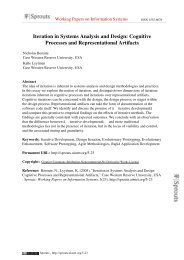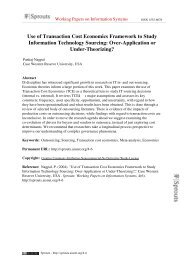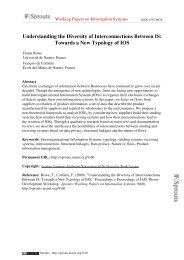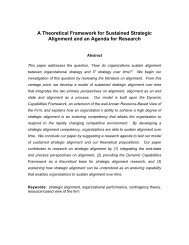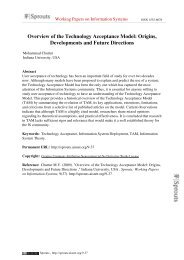Benefits are from Venus, Costs are from Mars - Sprouts - Association ...
Benefits are from Venus, Costs are from Mars - Sprouts - Association ...
Benefits are from Venus, Costs are from Mars - Sprouts - Association ...
You also want an ePaper? Increase the reach of your titles
YUMPU automatically turns print PDFs into web optimized ePapers that Google loves.
Working Papers on Information Systems ISSN 1535-6078<br />
<strong>Benefits</strong> <strong>are</strong> <strong>from</strong> <strong>Venus</strong>, <strong>Costs</strong> <strong>are</strong> <strong>from</strong> <strong>Mars</strong><br />
Peter Schuurman<br />
University of Groningen, The Netherlands<br />
Egon W. Berghout<br />
University of Groningen, The Netherlands<br />
Philip Powell<br />
University of Bath, United Kingdom<br />
Abstract<br />
Given the plethora of available information systems (IS) evaluation techniques, it seems<br />
unlikely that yet another technique will address the problems of unsuccessful projects and<br />
ineffective management. Rather, more insight into the foundations of evaluation techniques<br />
may yield greater benefits. One generally accepted, but largely unexplored, issue concerns<br />
objectivity and subjectivity in the assessment of costs and benefits. This research in progress<br />
demonstrates that, over time, the objectivity of evaluation approaches has diminished as they<br />
increasingly assess benefits. As cost measurements remain more objective, assessments that<br />
seek to comp<strong>are</strong> costs and benefits become more problematic; benefits <strong>are</strong> <strong>from</strong> <strong>Venus</strong>, costs<br />
<strong>are</strong> <strong>from</strong> <strong>Mars</strong> and their orbits <strong>are</strong> diverging. This research assesses why this is the case.<br />
Specifically, it examines different characteristics of costs and benefits and the divergence in<br />
their assessments. Then, a design science methodology is adopted to analyse the<br />
divergenceâs influence on evaluation methods, as well as the 'tweakabilityâ for closing<br />
the gap. In this paper it is argued that narrowing the gap, and particularly the objective<br />
measurement of IT benefits, is a prerequisite for a more general acceptance of IT evaluation<br />
methods. This insight may enable better understanding of some of the fundamental problems<br />
underlying IS evaluation.<br />
Keywords: Objectivity, IS evaluation, evaluation methods, IS economics<br />
Permanent URL: http://sprouts.aisnet.org/9-3<br />
Copyright: Creative Commons Attribution-Noncommercial-No Derivative Works License<br />
Reference: Schuurman, P.M., Berghout, E.W., Powell, P. (2009). "<strong>Benefits</strong> <strong>are</strong> <strong>from</strong> <strong>Venus</strong>,<br />
<strong>Costs</strong> <strong>are</strong> <strong>from</strong> <strong>Mars</strong>," University of Groningen, Netherlands . <strong>Sprouts</strong>: Working Papers on<br />
Information Systems, 9(3). http://sprouts.aisnet.org/9-3<br />
<strong>Sprouts</strong> - http://sprouts.aisnet.org/9-3
<strong>Benefits</strong> <strong>are</strong> <strong>from</strong> <strong>Venus</strong>, <strong>Costs</strong> <strong>are</strong> <strong>from</strong><br />
<strong>Mars</strong><br />
Peter Schuurman<br />
Egon Berghout<br />
Philip Powell<br />
CITER WP/010/PSEBPP<br />
June 2008<br />
University of Groningen<br />
Centre for IT Economics Research<br />
P.O. Box 800<br />
9700 AV Groningen<br />
The Netherlands<br />
<strong>Sprouts</strong> - http://sprouts.aisnet.org/9-3
CITER mission<br />
CITER is an independent research group within<br />
the Department of Economics, University of<br />
Groningen. Our research is focused on the<br />
economics of information technologies. Our<br />
research aims at understanding and analyzing<br />
the dynamics and the processes of<br />
development, distribution and<br />
implementation of infor-mation and<br />
communications technologies and improving<br />
their efficiency and effectiveness.<br />
We investigate particular economic issues in<br />
the economics of information technologies.<br />
For instance, the differences between ‘Open’<br />
and ‘proprietary’ technologies, the<br />
characteristics of hard-w<strong>are</strong> and softw<strong>are</strong><br />
commercial demand and supply and the<br />
diffusion of new technologies. We also study<br />
the efficient and effective use of those<br />
technologies, how we can improve IT<br />
management and increase the benefits of<br />
investment in information technologies.<br />
The objectives of our research <strong>are</strong> especially<br />
useful for organizations using information<br />
technologies and to firms competing in this<br />
<strong>are</strong>na, as well as to policy makers and to<br />
society as a whole.<br />
Our research is conducted in close cooperation<br />
with industry, non-profit organizations<br />
and governmental partners, as our field of<br />
research is subject to frequent techno-logical<br />
and political changes.<br />
Projects and main venues of research<br />
<br />
<br />
<br />
<br />
<br />
<br />
<br />
Cost/benefit management of IT.<br />
Decision-support methods for implementation decisions<br />
within organizations.<br />
Evaluation of legacy systems.<br />
Innovation and technical change in ICT.<br />
‘Open’ vs. ‘proprietary’ softw<strong>are</strong> modes of development.<br />
Softw<strong>are</strong> patenting and appropriation strategies.<br />
Tools and strategies for the IT Control Officer.<br />
Sponsors<br />
Getronics PinkRoccade<br />
UWV<br />
Researchers<br />
Prof. dr. E.W. Berghout<br />
Drs. Ing. A.L.<br />
Commandeur<br />
Dr. E. Harison<br />
Prof. dr. P. Powell<br />
Dr. T.J.W. Renkema<br />
P.M. Schuurman, MSc.<br />
E.J. Stokking, MSc.<br />
e.w.berghout@rug.nl<br />
a.l.commandeur@rug.nl<br />
e.harison@rug.nl<br />
mnspp@management.bath.ac.uk<br />
t.j.w.renkema@rug.nl<br />
p.m.schuurman@rug.nl<br />
e.j.stokking@rug.nl<br />
Contact information<br />
University of Groningen<br />
CITER-WSN245<br />
P.O. Box 800<br />
9700 AV Groningen<br />
The Netherlands<br />
Tel. +31-50-363-3864<br />
info@CITER.nl<br />
<strong>Sprouts</strong> - http://sprouts.aisnet.org/9-3
<strong>Benefits</strong> <strong>are</strong> <strong>from</strong> <strong>Venus</strong>, <strong>Costs</strong> <strong>are</strong> <strong>from</strong> <strong>Mars</strong><br />
Abstract<br />
Given the plethora of available information systems (IS) evaluation techniques, it seems unlikely that<br />
yet another technique will address the problems of unsuccessful projects and ineffective<br />
management. Rather, more insight into the foundations of evaluation techniques may yield greater<br />
benefits. One generally accepted, but largely unexplored, issue concerns objectivity and subjectivity in<br />
the assessment of costs and benefits. This research in progress demonstrates that, over time, the<br />
objectivity of evaluation approaches has diminished as they increasingly assess benefits. As cost<br />
measurements remain more objective, assessments that seek to comp<strong>are</strong> costs and benefits become<br />
more problematic; benefits <strong>are</strong> <strong>from</strong> <strong>Venus</strong>, costs <strong>are</strong> <strong>from</strong> <strong>Mars</strong> and their orbits <strong>are</strong> diverging. This<br />
research assesses why this is the case. Specifically, it examines different characteristics of costs and<br />
benefits and the divergence in their assessments. Then, a design science methodology is adopted to<br />
analyse the divergence’s influence on evaluation methods, as well as the ‘tweakability’ for closing the<br />
gap. In this paper it is argued that narrowing the gap, and particularly the objective measurement of<br />
IT benefits, is a prerequisite for a more general acceptance of IT evaluation methods. This insight may<br />
enable better understanding of some of the fundamental problems underlying IS evaluation.<br />
Keywords: Objectivity, IS evaluation, evaluation methods, IS economics<br />
Introduction<br />
Over the last 40 years an extensive portfolio of evaluation methods for information systems (IS) has<br />
been created. Despite some evidence of use (Al-Yaseen et al. 2006), their usefulness appears to be<br />
lacking as reports of the squandering of resources on unsuccessful projects and ineffective<br />
management persist (Latimore et al. 2004). Underpinning the problem complexity, as well as the<br />
disparity between theory and practice, these reports indicate that organizations <strong>are</strong> not benefiting<br />
<strong>from</strong> the potential value of IS evaluation and consequently improved decisions about which IS to<br />
invest in.<br />
Given the available ways and means, it seems unlikely that yet another technique would address<br />
these problems (Powell 1992). Rather, there is a need for more insight into the foundations of<br />
evaluation techniques, and their specific characteristics, use and value in practice. This research in<br />
progress focuses on the characteristics of the constellation of costs and benefits in the methods.<br />
Specifically, it addresses why the evaluation of IS business value does not deliver an effective, and<br />
feasible, constellation. Three questions <strong>are</strong> examined: (1) how different <strong>are</strong> costs and benefits, (2)<br />
what is the gap between the assessments of costs and of benefits in IS evaluation, and, assuming a<br />
gap exists, (3) how could this gap be reduced Given that IS evaluation research and practice has a<br />
history of over 40 years (Williams and Scott 1965), yet is neither well understood, nor routinely<br />
practised, insight into these questions may enable better understanding of some of the fundamental<br />
underlying problems of IS evaluation.<br />
A number of dimensions for assessing costs and benefits have emerged in the literature. One is the<br />
extent to which the elements of the evaluation may be considered ‘objective’ or ‘subjective’. In this<br />
paper, the body of evaluation methods is assessed based on the level to which they may be<br />
considered to be ‘objective’. It is explained here that there is diminishing objectivity as evaluation<br />
approaches increasingly assess benefits. As cost assessments tend to be more objective, it appears<br />
the two <strong>are</strong> moving apart - hence benefits <strong>are</strong> <strong>from</strong> <strong>Venus</strong> and costs <strong>are</strong> <strong>from</strong> <strong>Mars</strong>, and their orbits<br />
<strong>are</strong> diverging. In order to bring the orbits closer together, this research takes an approach in which<br />
the effects of change on a method <strong>are</strong> assessed as its level of objectivity is increased. To aid this<br />
<strong>Sprouts</strong> - http://sprouts.aisnet.org/9-3
approach, an objectified redesign of Bedell’s method (1985), previously considered as subjective, is<br />
presented, tested, and comp<strong>are</strong>d to the original.<br />
The paper is organized as follows. In the next section, the concept of objectivity in evaluation is<br />
addressed while taking into consideration the cost and benefits dimensions. Then, a review of IS<br />
evaluation methods progressively uncovers a response to the second research question. Based on<br />
this foundation, the research objectives and approach <strong>are</strong> discussed. The redesigned method is<br />
presented in the subsequent section and early results <strong>are</strong> considered. The final section concludes<br />
with the potential practical and theoretical contributions of the research.<br />
Objectivity in assessing costs and benefits<br />
Techniques to evaluate IS can be categorized in many ways. Each of these taxonomies highlights<br />
different characteristics; examples <strong>are</strong> timing (Remenyi et al. 2000), type of assessment (Renkema<br />
and Berghout 1997), and level of objectivity (Powell 1992). Typologies may aid organizations in their<br />
choice of appropriate methods to support their IS investments and other resource allocation choices.<br />
These justifications <strong>are</strong> assessed based on the business value to the organization. From an economic<br />
standpoint, this value can be considered the sum of all positive and negative consequences of the<br />
system. In an assessment of evaluation methods it is therefore important to consider how these<br />
elements <strong>are</strong> reconciled.<br />
In addition, the level of objectivity, while often mentioned, has received little fundamental<br />
examination in IS evaluation literature. Yet, the concept may prove valuable as higher levels of<br />
objectivity in the measurement and evaluation of the costs and benefits might be able to play a role<br />
in more commonly accepted and employed evaluation principles.<br />
In an app<strong>are</strong>nt common sense supposition, Powell (1992) states that objective measures seek to<br />
quantify system inputs and outputs in order to attach values to them; while subjective methods<br />
(usually qualitative) rely on attitudes, opinions and feelings. The latter part of this view is supported<br />
<strong>from</strong> a research philosophy perspective in which objectivity relates to objectivism, the ontological<br />
position stating that ‘social entities exist in reality external to social actors’; whereas subjectivity<br />
descends <strong>from</strong> subjectivism, arguing that these entities <strong>are</strong> created ‘<strong>from</strong> the perceptions and<br />
consequent actions of social actors’ (Saunders et al. 2006: p.108). Despite extensive and insightful<br />
philosophical considerations, influenced by Descartes, Kant, Foucault, and Nietzsche among many<br />
others (Darity 2008), concealed behind the concepts of objectivism and subjectivism, no empirically<br />
applicable definition to determine a level of objectivity has been established.<br />
In its purest form, objectivity would thus have no actors involved, but <strong>from</strong> a realism standpoint,<br />
ultimate objectivity would be reached by the elimination of the influence of the observer on the<br />
observation. However, accepting the observer as an element of the observation would lead<br />
objectivity to concern a sense of judgement and acceptance reflecting generally agreed principles.<br />
This, in turn, results in a situation in which neither objectivity nor subjectivity <strong>are</strong> absolute and<br />
mutually exclusive (Ford 2004). Therefore, for research on the objectivity of evaluation methods, it<br />
might be better to aspire to reduced subjectivity, rather than a futile aim for objectivity itself. This<br />
espouses Giddens’ (1984) view that the objectivity of a social systems depends on its enabling and<br />
constraining structural properties which create a range of feasible opportunities wherein the agent<br />
can be engaged; the smaller the range of options available, the lower the subjectivity.<br />
In assessing IS costs and benefits, it is possible to detect the presence of such differences in the level<br />
of objectivity, both between and within the two elements. On the one hand, the emphasis in IS<br />
benefits research lies heavily on non-financial aspects. Information systems <strong>are</strong> seen to positively<br />
contribution to the organization in three ways; (1) by facilitation things to be done which could not<br />
be done before, (2) by improving the things already done, and (3) by enabling the organization to<br />
cease activities that <strong>are</strong> no longer needed (Ward and Daniel 2006). The benefits of having IS can only<br />
<strong>Sprouts</strong> - http://sprouts.aisnet.org/9-3
e established through use by the organization (Tiernan and Peppard 2004). Problems arise with the<br />
measurement, allocation, and management of benefits. The lack of a workable definition for setting<br />
the boundaries of IS leaves the allocation of benefits to IS seemingly impossible. The intangibility of<br />
benefits confirms this impression. In addition, information is pervasive within the business and<br />
change will undoubtedly lead to second-order effects. When trying to create an overview of benefits<br />
for a potential change or investment identifying all direct and some indirect effects is a challenge. As<br />
boundaries fade after implementation, the identification of the contribution of an operational IS in<br />
the current business environment becomes even more problematic.<br />
Research on costs, on the other hand, has a dominant financial orientation in IS literature (e.g. Irani<br />
et al. 2006). IS costs can occur due to use of the system, as a consequence of having the system, and<br />
as a result of the processes supplying the system. A problem with identifying IS costs concerns which<br />
costs to include – costs for user training may be an IS cost category, but might also be hidden within<br />
the business. As IS costs <strong>are</strong> partially caused by the business, the IS provider is unable to control<br />
them; therefore an organization needs to have agreed processes on the allocation and measurement<br />
of IS costs. It is then possible to create insights into IS cost behaviour and manage and control them.<br />
It is these objectives that eventually determine the purposes of identifying IS costs. Little attention is<br />
paid to the so-called negative contributions, that is the non-financial burdens, of IS.<br />
Being better established and highly financially-oriented, various methods for accounting for the costs<br />
of IS exist. Methods such as Activity Based Costing <strong>are</strong> based on standard accounting approaches,<br />
and so, <strong>from</strong> one perspective it could be argued that cost management itself appears relatively<br />
objective and somewhat comparable – though it will depend on the quality of the data, the quality of<br />
the costing system and of the quality of the output or signals the system produces. Nonetheless, it is<br />
hoped that by c<strong>are</strong>ful cost categorization all sources of cost can be identified, and quantified, in a<br />
reasonably robustly manner. The attachment of values to inputs and outputs by evaluation<br />
techniques in order to create an objective aura, ‘quantification’, advocates ‘increases [in] precision<br />
and generalizability, while minimizing prejudice, favouritism, and nepotism in decision-making’<br />
(Darity 2008, p.655). That does not necessarily mean that the level of objectivity is high. As Power<br />
substantiates, ’below the wealth of technical procedure, the epistemic foundation of financial<br />
auditing,..is essentially obscure’ (1997, p.15), these procedures <strong>are</strong> based on an obscure knowledge<br />
base and the output is essentially an opinion. The supposed objectivity stems <strong>from</strong> ‘disciplinary<br />
objectivity’ (Megill 1994), earning its ‘acceptability to those outside a discipline depends on certain<br />
presumptions, which <strong>are</strong> r<strong>are</strong>ly articulated except under severe challenge’ (Porter 1995, p.4).<br />
No matter if the disciplinary appearance of objectivity is reached or not, a form of ‘procedural<br />
objectivity’ (aka. mechanical objectivity) can occur; essentially a practice reaching its objectivity by<br />
following rules (Porter 1995). These ‘rules <strong>are</strong> a check on subjectivity: they should make it impossible<br />
for personal biases or preferences to affect the outcome of an investigation’ (Porter 1995, p.4). They<br />
thus create high levels of standardization and reproducibility, which, as in science, might be further<br />
enhanced by triangulation. Comp<strong>are</strong>d to the established cost evaluation, no such rules, standard<br />
systems and accepted principles exist for IS benefits. It could be argued that there might be a need<br />
for an IS ‘profession’ to dictate how things should be done, but at present it appears to be an <strong>are</strong>a in<br />
which mechanical objectivity could be valuable. Availability of rules is not sufficient for procedural<br />
objectivity on its own, as other properties <strong>are</strong> of influence. Applying rules will often require some<br />
kind of valuation by the actor involved. The more situations which require actor judgement and the<br />
more complex these judgements, the lower the objectivity. This effect is called ‘multiple subjectivity’<br />
(Berghout 1997). The effect may be moderated by use of triangulation. As in research, triangulated<br />
data enable the actor to ascertain the statements made.<br />
In both the situations of procedural and disciplinary objectivity, the level of objectivity is determined<br />
by the position of the actor who either somehow obtains disciplinary approbation or follows the<br />
mechanics in order to employ the evaluation, as well as the other actors involved. An actor can and<br />
might positively or negatively influence the objectivity, based on his power, the ability to actually<br />
<strong>Sprouts</strong> - http://sprouts.aisnet.org/9-3
influence, knowledge, the ability of how to influence, and interest, the willingness to influence.<br />
Although all <strong>are</strong> required to influence, neither will ensure employment. Apart <strong>from</strong> depending on the<br />
position of the actors, objectivity is ‘practised in a particular time and place by a community of people<br />
whose interests, hence standards and goals, change with particular sociocultural and political<br />
situations’ (Feldman 2004). Hence, there <strong>are</strong> objectivity stimulating elements for methods and<br />
participants and these elements will also interact. An evaluation method that could be deemed<br />
objective at a given time, might thus lose this objectivity due to subjective manipulation by the actors<br />
involved.<br />
Based on this analysis, the assessment of the objectivity of evaluation methods requires a review<br />
<strong>from</strong> multiple viewpoints. With regard to the disciplinary objectivity, all methods appeal to the same<br />
disciplinary foundation; therefore, a comparison is unlikely to show any differences here. The aspects<br />
which relate to the mechanical objectivity however open up possibilities for analysing levels of<br />
objectivity. Several aspects <strong>are</strong> distinguished concerning provided rules. The availability of guidelines<br />
on the selection of the object under evaluation – the what aspect – provide the evaluator with a<br />
reference framework for the boundaries of the assessment. In view of the complex nature of<br />
information systems, these rules <strong>are</strong> a prerequisite for objectivity. Having established the<br />
evaluation’s focus, rules on the procedures of evaluation – the how aspect – will guide the evaluation<br />
in the process of employing the analysis. This is the part in which rules for identifying cost and<br />
benefits <strong>are</strong> to be found, as well as guidance to bring cost and return to a common base. Use of<br />
triangulated data further enables objectivity in this aspect. After the evaluation process, the outcome<br />
of the evaluation needs to be addressed. Rules on the criteria to be used in this action – the which<br />
aspect – contribute to the mechanical objectivity of an evaluation method by uniforming the<br />
interpretation. These rules <strong>are</strong> closely linked to the procedural rules, but differ in that they guide<br />
meaning rather than operation. Next to the rules connected to the evaluation process, two more<br />
aspects can be identified in the evaluation’s environment. The first concerns the stakeholders<br />
involved in the evaluation – the who aspect. Active stakeholder management will increase support<br />
for the evaluation as well as the triangulation of data. Additionally, facilitating issues – the why<br />
aspect – regard the embedment of the evaluation in the organization. Issues involved include<br />
supported learning capabilities, communication facilitation, and reporting guidance. An overview of<br />
the aspects is provided in Table 1.<br />
Code<br />
MO1<br />
MO2<br />
MO3<br />
MO4<br />
MO5<br />
Table 1.<br />
Rules regarding the ... of evaluation<br />
Object<br />
Procedures<br />
Criteria<br />
Stakeholders<br />
Facilitation<br />
Aspects influencing mechanical objectivity<br />
The evaluation of cost and benefits provides most value for organizations when they can be directly<br />
comp<strong>are</strong>d. Surveying the current state, the problems with evaluation of the two <strong>are</strong> different. Given<br />
the accounting standards in place, cost accounting for information systems seems to be converging<br />
to a more standard practice with increasing of objectivity or at the very least, uniformity.<br />
Developments in IS benefits assessment however appears to be lagging behind in this line of work.<br />
While the evaluation of cost struggles with relative objective issues such as addressing the right cost<br />
drivers and determining acceptable levels of costs, the assessment of benefits has not similarly<br />
progressed <strong>from</strong> the more subjective identification <strong>are</strong>a. <strong>Benefits</strong> and cost thus appear to have a<br />
different ‘denominator’, making them app<strong>are</strong>ntly unsuitable to combine in a single evaluation in<br />
their current form. In the next section, the consequences of this dissimilarity of evaluation methods<br />
<strong>are</strong> discussed by subjecting their costs and benefits constellations to the degrees of objectivity.<br />
<strong>Sprouts</strong> - http://sprouts.aisnet.org/9-3
Mechanical objectivity aspect<br />
Technique (IS) Source MO1<br />
Object<br />
MO2<br />
Procedures<br />
MO3<br />
Criteria<br />
MO4<br />
Stakeholders<br />
MO5<br />
Facilitation<br />
Cost value Joslin, 1977 Project Financial None None None<br />
technique (in Powell 1992)<br />
Cost benefit Lay, 1985 Project Financial None None None<br />
analysis (in Powell 1992)<br />
Method of Bedell, 1985 Project, Implicit None Mgmt, users, Portfolio<br />
Bedell<br />
organization substitutes<br />
automation management<br />
Value chain<br />
analysis<br />
Porter and<br />
Millar, 1985<br />
Organization Cost and<br />
value drivers<br />
None None Action plan<br />
steps<br />
Internal rate of Weston and Project Financial None None None<br />
return<br />
Copeland, 1986<br />
Net present Weston and Project Financial None None None<br />
value<br />
Copeland, 1986<br />
SESAME Lincoln, 1986 Project Financial,<br />
categories<br />
and <strong>are</strong>as<br />
None Users Managemen<br />
t<br />
recommendations<br />
Return on<br />
investment<br />
Weston and<br />
Copeland, 1986<br />
Project Financial None None None<br />
Information<br />
economics<br />
Return on<br />
management<br />
Option theory<br />
Balanced<br />
scorecard<br />
Benefit<br />
realization<br />
approach<br />
Benefit<br />
management<br />
approach<br />
Parker et al.,<br />
1988<br />
Strassmann,<br />
1990<br />
Dos Santos,<br />
1991<br />
Kaplan and<br />
Norton, 1992<br />
Project<br />
Financial,<br />
business and<br />
IS criteria<br />
None<br />
Managemen<br />
t<br />
None<br />
Organization Financial None None None<br />
Project<br />
Project,<br />
organization<br />
Thorp, 1998 Project Perspectives,<br />
methods to<br />
be<br />
embedded<br />
Ward and<br />
Daniel, 2006<br />
Project<br />
Financial,<br />
probabilities<br />
None None Managemen<br />
t flexibility<br />
Perspectives, None Managemen None<br />
no explicit<br />
t<br />
measures<br />
None Managemen Results chain<br />
t<br />
Benefit<br />
identification<br />
supported,<br />
business<br />
measures<br />
Val IT ISACA, 2007 Organization Business<br />
case, not<br />
explicit<br />
Table 2.<br />
Diverging orbits<br />
None<br />
None<br />
Sources of mechanical objectivity in IS evaluation methods<br />
Managemen<br />
t<br />
Managemen<br />
t<br />
Process<br />
Processes<br />
Against this understanding of the concept of objectivity in IS evaluation, the evaluation techniques<br />
themselves can be addressed. Fifteen techniques were selected in order to get a representative<br />
cross-section of the available evaluation methods portfolio. The selection together with the method’s<br />
original IS source is presented arranged in order of occurrence in Table 2. It is compiled using the<br />
time-line of Bannister et al. (2006) in order to cover the changing concepts of IS to a degree. It<br />
includes a wide selection of the most classical examples, as well as conceptual backgrounds. One or<br />
more representatives <strong>are</strong> included for each of the categories of financial, multi-criteria, ratio, and<br />
<strong>Sprouts</strong> - http://sprouts.aisnet.org/9-3
portfolio methods. The objectivity of methods is assessed using the aspects as prep<strong>are</strong>d in the<br />
previous section (Table 1). In Table 2 the identified sources of mechanical objectivity in the<br />
evaluation methods <strong>are</strong> listed on each of the aspects. Where possible the original sources, as<br />
referred to in the table, where used. In addition, IS evaluation literature was consulted for<br />
information on the methods (e.g. Van Grembergen 2001, Renkema and Berghout 2005). It should be<br />
emphasized that the information provides no value judgement on any property other than<br />
mechanical objectivity.<br />
In general, the guidance provided on each of the five aspects is seen to be low. A number of external<br />
factors might be attributed to this, among which <strong>are</strong> the intended scope of either the references or<br />
the description of the methods. This is likely to be the case on the matters of the object under<br />
evaluation, criteria of evaluation, stakeholders, and facilitation. For instance, the object under<br />
evaluation is seen to be (IT) projects and/or the (IT) organization. Setting the boundaries of such<br />
entities entails issues far <strong>from</strong> the focus of any method explanation. As is the case with stakeholder<br />
management, on which little special guidance is provided other than information on the use of the<br />
method by (senior) management. When considering the aspects of facilitation and criteria of using<br />
the evaluation outcome, a similar argument holds. Either methods <strong>are</strong> intended for use within a<br />
broader scope, such as any of the financial methods, or the scope of the methods is broader than<br />
one on which the aspects <strong>are</strong> used; this is the case for methods providing an organizational<br />
framework.<br />
On the aspect of procedures, the previous reasoning however does not hold. The procedures form<br />
the essence of the methods and therefore the internal rules on how to employ a method <strong>are</strong><br />
provided in detail. Nevertheless, looking beyond the internal rules, guidance on the data to obtain<br />
and process creates a foundation for subjectivity as boundaries <strong>are</strong> not set. As the older evaluation<br />
techniques <strong>are</strong> an outgrowth of traditional cost-benefit methodologies their total objectivity relies on<br />
their disciplinary qualities. Moving forward in time, objectivity diminishes on the aspect of<br />
procedures as the evaluation approaches increasingly <strong>are</strong> enabled to assess benefits. Increasingly,<br />
evaluation methods offer a framework which is customized for the organization employing the<br />
technique, rather than a ready to use assessment. As the objectivity of cost measurements relies on<br />
similar foundations throughout the selected portfolio of evaluation techniques, it appears that the<br />
two <strong>are</strong> moving apart; benefits <strong>are</strong> <strong>from</strong> <strong>Venus</strong> and costs <strong>are</strong> <strong>from</strong> <strong>Mars</strong>, and their orbits <strong>are</strong><br />
diverging.<br />
Next, the research focuses on reducing this divergence by tackling the need to make the benefit<br />
element better match its cost counterpoint.<br />
Methodology<br />
The previous section demonstrates IS evaluation methods to be progressively adopting a subjective<br />
approach. The consequences of this gap between objectivity and subjectivity for techniques <strong>are</strong> now<br />
assessed. For this, a design science research methodology, as described by Peffers et al. (2007) is<br />
adopted in order to design a method in which the gap is at least narrowed. Design science is<br />
preferred over a behavioural paradigm as the objective is to develop guidance and utility on how to<br />
design a usable and useful IS evaluation method (Markus et al. 2002, Hevner et al. 2004, Van Aken<br />
2004).<br />
Peffers’ methodology consists of six activities: the identification of the problem and motivation,<br />
defining objectives for the solution (Sections 1-3), design and development, demonstration,<br />
evaluation, and communication activities. The latter two loop back to the second and third, as to<br />
create a flow of progressive improvement of the designed solution and its problem solving capacity.<br />
Building on literature research and exploratory research on the original, Bedell’s method (1985) is<br />
redesigned to increase its level of objectivity (Section 5). By reflecting an amended method back on<br />
its origin not only can insights be provided into the influence of objectivity on IS evaluation, but also<br />
<strong>Sprouts</strong> - http://sprouts.aisnet.org/9-3
the general ‘tweakability’ of techniques can be addressed. Future research on other characteristics<br />
and trade-offs between those characteristics could then be served by this insight. In addition, the<br />
quality and usefulness of the redesigned method <strong>are</strong> tested. Bedell’s method was selected for its<br />
thorough organizational structure and high internal consistency.<br />
The demonstration activity of the methodology, occurring several times because of the feedback<br />
loops, is implemented as a field study. Field research sees to the testing of the design in a natural<br />
problem environment, demonstrating the design in situations in which it is supposed to work. Each<br />
loop consists of a case study in which three steps <strong>are</strong> distinguished: introduction, data gathering and<br />
processing for the method, and outcome and research assessment. First, during the introduction the<br />
organization is familiarized with the research process and the designed method. The required data is<br />
located and, if necessary, substitute variables <strong>are</strong> identified and selected. In addition, a quick-scan of<br />
the IS department is made. Second, the organization provides data and the design is employed by the<br />
researchers. A report is drafted and fed back to the organization for initial comments. Last, a meeting<br />
is arranged in which the outcome of the method <strong>are</strong> discussed with the organization. Inaccuracies<br />
<strong>are</strong> mapped and amendments <strong>are</strong> discussed. So as to demonstrate the design under a rich variety of<br />
circumstances, the portfolio of participation organizations contains large as well as small/medium<br />
enterprises <strong>from</strong> diverse lines of business and employing different IS (sourcing) strategies.<br />
Next, the design is evaluated based on the quick-scan executed in the introduction step of each case<br />
study. In the later stages the design is validated and assessed in comparison to the original method.<br />
As the designed method only uses data that cannot be influenced by the organization, no<br />
interference issues <strong>are</strong> expected in employing the original method and gathering data for the design.<br />
The overall research model is illustrated in Figure 1. The next section discusses in more detail the<br />
development and design of the modified method of Bedell.<br />
Figure 1.<br />
Overview of the research design<br />
Setting course for objectivity<br />
Original and redesign<br />
Less well-known than evaluation methods such as Information Economics and the Balanced<br />
Scorecard, Bedell’s method is a classical example of a portfolio approach. Bedell first published his<br />
method in 1985 in: The computer solution: Strategies for success in the information age, illustrating<br />
the battle of reducing administrative perfection and bringing more IS resources to the core business<br />
processes. The method links business value to information systems in a systematic way, providing<br />
portfolios such as the ones visualized in Figure 2. The most important principle of the method is that<br />
the level of effectiveness of the information systems should ideally be approximately equal to their<br />
level of strategic importance. The effectiveness functions as the ‘as-is’ situation, whereas importance<br />
indicates the ‘to-be’ situation. This way, ineffective systems (comp<strong>are</strong>d to their importance) indicate<br />
<strong>are</strong>as for improvement, while outperforming ones should be kept stable, or might even receive less<br />
attention than in the current situation.<br />
<strong>Sprouts</strong> - http://sprouts.aisnet.org/9-3
1<br />
2<br />
1<br />
BP1<br />
Organization<br />
3<br />
2<br />
3<br />
BP2<br />
BP3<br />
4<br />
4<br />
BP4<br />
Low<br />
Figure 2.<br />
Effectiveness of IS to the<br />
organization<br />
High<br />
Low<br />
High<br />
Effectiveness of IS to the business<br />
process<br />
Organization and business process level portfolios in the original Bedell<br />
The method provides decision support for IS resource allocation questions via portfolios, all<br />
comparable to the one in Figure 2, for each of three levels of the organization; these <strong>are</strong> determined<br />
to be (1) the entire organization, which (2) consists of a set of business processes, that (3) each<br />
consist of activities. The portfolios <strong>are</strong> linked bottom-up by a series of equations primarily weighing<br />
lower level variables with the importance variable of the higher level; the exact equations <strong>are</strong><br />
considered beyond the scope of this paper but <strong>are</strong> available in Schuurman, Berghout and Powell<br />
(2008).<br />
All variables involved in the original measure either some kind of importance or effectiveness. The<br />
values <strong>are</strong> determined in sessions with representatives <strong>from</strong> both business and IS, in which they <strong>are</strong><br />
required to reach a consensus. These sessions require a considerable amount of top management<br />
time, and could be hampered by the potential differences in viewpoints on and understanding of the<br />
concepts involved. As concluded in Section 3, objectivity in the aspects of the evaluated object,<br />
procedures, and stakeholders is thus perceived to be low. Nonetheless, on the aspects of internal<br />
rules, the method’s equation system obtains a high score. For this reason it provides a good starting<br />
point for the design of an evaluation method meeting the requirements of objectivity. Next, the<br />
foundations of the design <strong>are</strong> expounded. Then the alterations to the original Bedell <strong>are</strong> provided<br />
together with the reasons for implementation. The overall picture is illustrated in Figure 3.<br />
Figure 3.<br />
The design<br />
The redesign consists of six steps that <strong>are</strong> briefly described next. (1) A business process blueprint is<br />
made of the organization in question. Each business process is then awarded a score for its<br />
importance to the organization. The scoring principle is discussed later. (2) Every information system<br />
in the IS portfolio, or for empirical reasons the application portfolio, is linked to the business<br />
processes it supports. This link is accompanied with two scores, one for its effectiveness in<br />
supporting the business process and another for its importance for the business process. (3) The data<br />
on the single information systems is aggregated to a business process level; that is, the effectiveness<br />
and importance of is calculated for all IS supporting a particular business process. The aggregated<br />
value is calculated by weighing the scores per system by their importance for the business process.<br />
All other equations used in the redesign apply a similar approach. (4) The importance of all<br />
information systems for a certain business process <strong>are</strong> weighted by the importance of the business<br />
<strong>Sprouts</strong> - http://sprouts.aisnet.org/9-3
process to the organization. A high score on these, so-called, focus factors, not only indicates that IS<br />
<strong>are</strong> regarded highly important to the business process, but also that they <strong>are</strong> important in an <strong>are</strong>a<br />
crucial to the organization. (5) Next, the importance and effectiveness of all IS with regard to the<br />
organization as a whole <strong>are</strong> calculated. Herewith creating the two variables which indicate the<br />
general situation of IS in the organization. (6) Finally, as all variables <strong>are</strong> now known, the portfolios<br />
can be created. The three types of portfolios <strong>are</strong> the importance versus effectiveness of (i) single<br />
systems to a business process, (ii) all IS to the business processes, and (iii) all IS to the organization.<br />
The portfolios themselves <strong>are</strong> similar to the ones in Figure 3.<br />
In the quest for objectivity, four alterations <strong>are</strong> incorporated in this design when comp<strong>are</strong>d to the<br />
original technique; these <strong>are</strong> (1) reduced organizational complexity, (2) increased factuality of the<br />
network model between IS and business processes, (3) increased internal consistency, and (4)<br />
measurement of variables using substitute units. Each of these is briefly discussed next.<br />
The first change is to reduce the number of organizational levels to two in order to increase<br />
transp<strong>are</strong>ncy and lessen complexity. The organizational level of activity is eliminated, leaving a<br />
framework in place of information systems supporting the business processes. This change decreases<br />
the level of multiple subjectivity and enhances the reproducibility of input, therefore the objectivity<br />
<strong>from</strong> rules regarding the procedures of evaluation is increased. In addition, increased transp<strong>are</strong>ncy<br />
and understandability increases the facilitation aspect.<br />
The second modification, converts the original one-to-one relationship model between IS and<br />
business processes to an n-to-n relationship; thus supporting multiple systems per business process<br />
and multiple business processes per system. Admittedly, this change is more focused on the<br />
applicability of the method than the objectivity, but is nonetheless indispensable as, given the<br />
current complex network of interactions between IS and business processes, the one-to-one model<br />
of the original Bedell does not appear fit for purpose. Consequently, this change touches the aspect<br />
of defining the object under evaluation.<br />
The third alteration made is intended to increase internal consistency and transp<strong>are</strong>ncy; expanding<br />
the procedural rules aspect of objectivity. In comparison to the original, the created equations have<br />
an increased logic and consistency. As the equations <strong>are</strong> recursive, a virtually unlimited number of<br />
organizational levels can be added. For each level added, the level directly below the additional level<br />
is given an importance score for the new level. Next, all effectiveness and importance scores of the<br />
lower level <strong>are</strong> simply weighed against this new importance score. This uniformity enables the<br />
addition of as many organizational layers as needed. As shown in the first alteration, adding layers<br />
would, however, lower objectivity.<br />
The last change comprises replacing importance and effectiveness with substitute variables.<br />
Although not visible in the six steps described above, this can be regarded as the most important<br />
modification. By initially assessing the reproducibility of input, and possibly in later iterations of the<br />
design also the triangulation of input, this is the most substantial step towards the desired objectivity<br />
in both the aspects of the object under evaluation and the procedures to be used. Contrary to<br />
previous arrangements, the effectiveness and importance measures <strong>are</strong> not measured by<br />
conversation and consensus, but by using readily available measures <strong>from</strong> the organization’s (IS)<br />
management information. Herewith testing a portfolio method that is enhanced with measurements<br />
of objectified conditions. These include various measures <strong>from</strong> information systems service<br />
management (frameworks). Building on the Sh<strong>are</strong>holder Value Approach by Rappaport (1998), the<br />
importance of business processes to the organization is calculated by means of the fragment the<br />
business process adds to the profit margin of the organization. The effectiveness and importance of<br />
IS to the business processes <strong>are</strong> replaced by scores based on IS service management variables, such<br />
as the numbers of calls and changes.<br />
Overall, the four alterations <strong>are</strong> seen to affect the object, procedures, and facilitation rules available.<br />
In later iteration the stakeholders and criteria rules <strong>are</strong> also addressed. In addition, the variables<br />
<strong>Sprouts</strong> - http://sprouts.aisnet.org/9-3
described <strong>are</strong> the ones chosen for the first iteration of the design. Coming iterations will test other<br />
variables, including rules on handling cost and returns. This way the ‘tweakability’ of all aspects of<br />
objectivity as developed in Section 2 is studied throughout the research. Progress on the first<br />
iteration is described in the next paragraph.<br />
First demonstration<br />
Initiation of the first iteration cycle of the design took place at a production organization in late 2008.<br />
The organization has about 500 employees of whom up to 300 <strong>are</strong> IS users in some form, and it<br />
produces four to five billion products a year.<br />
Before the initial interview, softw<strong>are</strong> was created to support the automated handling of the data and<br />
the creation of the desired portfolios. In the first interview information was gathered on the business<br />
process blueprint of the organization as well as the application portfolio. In total, the organizational<br />
overview was set at nine business processes. The application portfolio contains seven main<br />
application; among which a central administrative system, an organization width production support<br />
application, and office automation. Based on this the organizational design of the method was<br />
incorporated into the softw<strong>are</strong>. In addition, data sources were acquired on the service management<br />
characteristics of the applications, as well as the financial data for the organization’s business<br />
processes. However, as the data was not readily available in the format required by the method, its<br />
acquisition is still in progress. The final data <strong>are</strong> expected December 2008. After processing the data,<br />
the discussion session can be planned; finalizing the first iteration by the end of 2008.<br />
Depending on the intermediate results as well as the final session, the design will be adjusted. Early<br />
results indicate that the required data in the current design <strong>are</strong> available at the case organization.<br />
Also, the developed softw<strong>are</strong> handles the data, where needed supplemented by exemplar data, as<br />
intended but has to be improved in the <strong>are</strong>as of usability, flexibility, and clarity. In addition, it is<br />
expected that due to the use of relative numbers, the method is prone to small numbers; something<br />
which will be dealt with in future redesigns.<br />
Potential contributions<br />
For research, the identification of objectivity as one of the possible causes for existing methods not<br />
being the expected success adds to the foundations upon which IS <strong>are</strong> evaluated. In addition, the<br />
knowledge gained of the methods, their design, use, and ‘tweakability’ will provide a framework in<br />
which other properties, such as the usefulness and complexity, can be researched. Gaining insights<br />
into the multiple properties of evaluation techniques will then enable future research on trade-offs<br />
between the various properties.<br />
This research particularly addresses the issues as to whether questionable benefit analysis<br />
techniques <strong>are</strong> the main reason for the faltering of IS evaluation. The contributions of this research<br />
to practice <strong>are</strong> twofold. First, providing guidance in how to use certain evaluation approaches in<br />
practice, and which data to include, offers practitioners the possibility of increasing the formality of<br />
the assessments. This offers improved potential to address resources allocated to IS and increased<br />
credibility of the IS function. Second, practice might take advantage of the research by improving the<br />
transition between the project business case <strong>from</strong> the realization phase and the economic<br />
management of operational information systems during exploitation.<br />
References<br />
Al-Yaseen, H., Eldabi, T., Lees, D. Y. and Paul, R. J. (2006) Operational Use evaluation of IT<br />
investments: An investigation into potential benefits. European Journal of Operational Research,<br />
173(3), 1000-1011.<br />
<strong>Sprouts</strong> - http://sprouts.aisnet.org/9-3
Bannister, F., Berghout, E. W., Griffiths, P. and Remenyi, D. (2006) In Proceedings of the 13th<br />
European Conference on Information Technology Evaluation. (Eds, Remenyi, D. and Brown, A.),<br />
Academic conferences Ltd., Reading.<br />
Bedell, E. F. (1985) The computer solution: Strategies for success in the information age. USA.<br />
Berghout, E. W. (1997) Evaluation of information system proposals: Design of a decision support<br />
method. Delft University of Technology.<br />
Darity, W. A. j. (2008) International encyclopedia of the social sciences. Macmillan Reference USA,<br />
Detroit.<br />
Dos Santos, B. L. (1991) Justifying Investments in New Information Technologies. Journal of<br />
Management Information Systems, 7(4), 71-89.<br />
Feldman, S. P. (2004) The culture of objectivity: Quantification, uncertainty, and the evaluation of risk<br />
at NASA. Human Relations, 57(6), 691-718.<br />
Ford, N. (2004) Creativity and convergence in information science research: The roles of objectivity<br />
and subjectivity, constraint, and control. Journal of the American Society for Information Science<br />
and Technology, 55(13), 1169-1182.<br />
Giddens, A. (1984) The constitution of society: Outline of the theory of structuration. University of<br />
California Press, Berkeley, etc.<br />
Hevner, A., March, S., Park, J. and Ram, S. (2004) Design science in information systems research. MIS<br />
Quarterly, 28(1), 75-105.<br />
Irani, Z., Ghoneim, A. and Love, P. E. D. (2006) Evaluating cost taxonomies for information systems<br />
management. European Journal of Operational Research, 173(3), 1103-1122.<br />
ISACA (2007) Val IT overview. http://www.isaca.org/valit/. html accessed in [2008-05-04].<br />
Kaplan, R. S. and Norton, D. P. (1992) The Balanced Scorecard--Measures That Drive Performance.<br />
Harvard Business Review, 70(1), 71-79.<br />
Latimore, D. W., Petit dit de la Roche, C., Quak, K. and Wiggers, P. (2004) Reaching efficient frontiers<br />
in IT investment management: What financial services CIOs can learn <strong>from</strong> portfolio theory. IBM<br />
Global Business Services.<br />
Lincoln, T. (1986) Do computer systems really pay-off Information & Management, 11(1), 25-34.<br />
Markus, M. L., Majchrzak, A. and Gasser, L. (2002) A design theory for systems that support emergent<br />
knowledge processes. MIS Quarterly, 26(3), 179-212.<br />
Megill, A. (1994) Rethinking objectivity. Duke University Press.<br />
Parker, M. M., Benson, R. J. and Trainor, H. E. (1988) Information economics: Linking business<br />
performance to information technology. Prentice-Hall International, Englewood Cliffs, New Jersey.<br />
Peffers, K. E. N., Tuunanen, T., Rothenberger, M. A. and Chatterjee, S. (2007) A Design Science<br />
Research Methodology for Information Systems Research. Journal of Management Information<br />
Systems, 24(3), 45-77.<br />
Porter, M. E. and Millar, V. E. (1985) How information gives you competitive advantage. Harvard<br />
Business Review, 63(4), 149-160.<br />
Porter, T. M. (1995) Trust in numbers: The pursuit of objectivity in science and public life. Princeton<br />
University Press, Princeton, New Jersey.<br />
Powell, P. L. (1992) Information technology evaluation: Is it different The Journal of the Operational<br />
Research Society, 43(1), 29-42.<br />
Power, M. (1997) The audit society: Rituals of verification. Oxford University Press, Oxford.<br />
Rappaport, A. (1998) Creating sh<strong>are</strong>holder value: A guide for manages and investors. The Free Press,<br />
New York, NY.<br />
Remenyi, D., Money, A. and Sherwood-Smith, M. (2000) The effective measurement and<br />
management of IT costs and benefits. Butterworth-Heinemann, Oxford (etc.).<br />
Renkema, T. J. W. and Berghout, E. W. (1997) Methodologies for information systems investment<br />
evaluation at the proposal stage: a comparative review. Information and Softw<strong>are</strong> Technology,<br />
39(1), 1-13.<br />
Renkema, T. J. W. and Berghout, E. W. (2005) Investeringsbeoordeling van IT-projecten: Een<br />
methodische benadering (in Dutch).<br />
<strong>Sprouts</strong> - http://sprouts.aisnet.org/9-3
Saunders, M., Lewis, P. and Thornhill, A. (2006) Research methods for business students. Financial<br />
Times/Prentica Hall, Harlow.<br />
Schuurman, P., Berghout, E.W., and Powell, P. (2008) Calculating the importance of information<br />
systems: The method of Bedell revisited, in: Citer Working Paper Series, Centre for IT Economics,<br />
University of Groningen, 1-20, www.citer.nl.<br />
Strassmann, P. A. (1990) The business value of computers: An executive's guide. Information<br />
Economic Press, New Canaan.<br />
Thorp, J. (1998) The information paradox: Realizing the business benefits of information technology.<br />
McGraw-Hill, Toronto.<br />
Tiernan, C. and Peppard, J. (2004) Information technology: Of value or a vulture European<br />
Management Journal, 22(6), 609-623.<br />
Van Aken, J. E. (2004) Management Research Based on the Paradigm of the Design Sciences: The<br />
Quest for Field-Tested and Grounded Technological Rules. Journal of Management Studies, 41(2),<br />
219-246.<br />
Van Grembergen, W. (2001) Information technology evaluation methods and management. Idea<br />
Group Publishing, Hershey, PA (etc.).<br />
Ward, J. and Daniel, E. (2006) <strong>Benefits</strong> management: Delivering value <strong>from</strong> IS & IT investments. John<br />
Wiley & Sons Ltd., Chichester.<br />
Weston, J. F. and Copeland, T. E. (1986) Managerial finance. The Dryden Press, New York, NJ.<br />
Williams, B. R. and Scott, W. P. (1965) Investment proposals and decisions. George Allen & Unwin<br />
Ltd., London.<br />
<strong>Sprouts</strong> - http://sprouts.aisnet.org/9-3
Editors:<br />
Michel Avital, University of Amsterdam<br />
Kevin Crowston, Syracuse University<br />
Working Papers on Information Systems | ISSN 1535-6078<br />
Advisory Board:<br />
Kalle Lyytinen, Case Western Reserve University<br />
Roger Clarke, Australian National University<br />
Sue Conger, University of Dallas<br />
Marco De Marco, Universita’ Cattolica di Milano<br />
Guy Fitzgerald, Brunel University<br />
Rudy Hirschheim, Louisiana State University<br />
Blake Ives, University of Houston<br />
Sirkka Jarvenpaa, University of Texas at Austin<br />
John King, University of Michigan<br />
Rik Maes, University of Amsterdam<br />
Dan Robey, Georgia State University<br />
Frantz Rowe, University of Nantes<br />
Detmar Straub, Georgia State University<br />
Richard T. Watson, University of Georgia<br />
Ron Weber, Monash University<br />
Kwok Kee Wei, City University of Hong Kong<br />
Sponsors:<br />
<strong>Association</strong> for Information Systems (AIS)<br />
AIM<br />
itAIS<br />
Addis Ababa University, Ethiopia<br />
American University, USA<br />
Case Western Reserve University, USA<br />
City University of Hong Kong, China<br />
Copenhagen Business School, Denmark<br />
Hanken School of Economics, Finland<br />
Helsinki School of Economics, Finland<br />
Indiana University, USA<br />
Katholieke Universiteit Leuven, Belgium<br />
Lancaster University, UK<br />
Leeds Metropolitan University, UK<br />
National University of Ireland Galway, Ireland<br />
New York University, USA<br />
Pennsylvania State University, USA<br />
Pepperdine University, USA<br />
Syracuse University, USA<br />
University of Amsterdam, Netherlands<br />
University of Dallas, USA<br />
University of Georgia, USA<br />
University of Groningen, Netherlands<br />
University of Limerick, Ireland<br />
University of Oslo, Norway<br />
University of San Francisco, USA<br />
University of Washington, USA<br />
Victoria University of Wellington, New Zealand<br />
Viktoria Institute, Sweden<br />
Editorial Board:<br />
Margunn Aanestad, University of Oslo<br />
Steven Alter, University of San Francisco<br />
Egon Berghout, University of Groningen<br />
Bo-Christer Bjork, Hanken School of Economics<br />
Tony Bryant, Leeds Metropolitan University<br />
Erran Carmel, American University<br />
Kieran Conboy, National U. of Ireland Galway<br />
Jan Damsgaard, Copenhagen Business School<br />
Robert Davison, City University of Hong Kong<br />
Guido Dedene, Katholieke Universiteit Leuven<br />
Alan Dennis, Indiana University<br />
Brian Fitzgerald, University of Limerick<br />
Ole Hanseth, University of Oslo<br />
Ola Henfridsson, Viktoria Institute<br />
Sid Huff, Victoria University of Wellington<br />
Ard Huizing, University of Amsterdam<br />
Lucas Introna, Lancaster University<br />
Panos Ipeirotis, New York University<br />
Robert Mason, University of Washington<br />
John Mooney, Pepperdine University<br />
Steve Sawyer, Pennsylvania State University<br />
Virpi Tuunainen, Helsinki School of Economics<br />
Francesco Virili, Universita' degli Studi di Cassino<br />
Managing Editor:<br />
Bas Smit, University of Amsterdam<br />
Office:<br />
<strong>Sprouts</strong><br />
University of Amsterdam<br />
Roetersstraat 11, Room E 2.74<br />
1018 WB Amsterdam, Netherlands<br />
Email: admin@sprouts.aisnet.org



